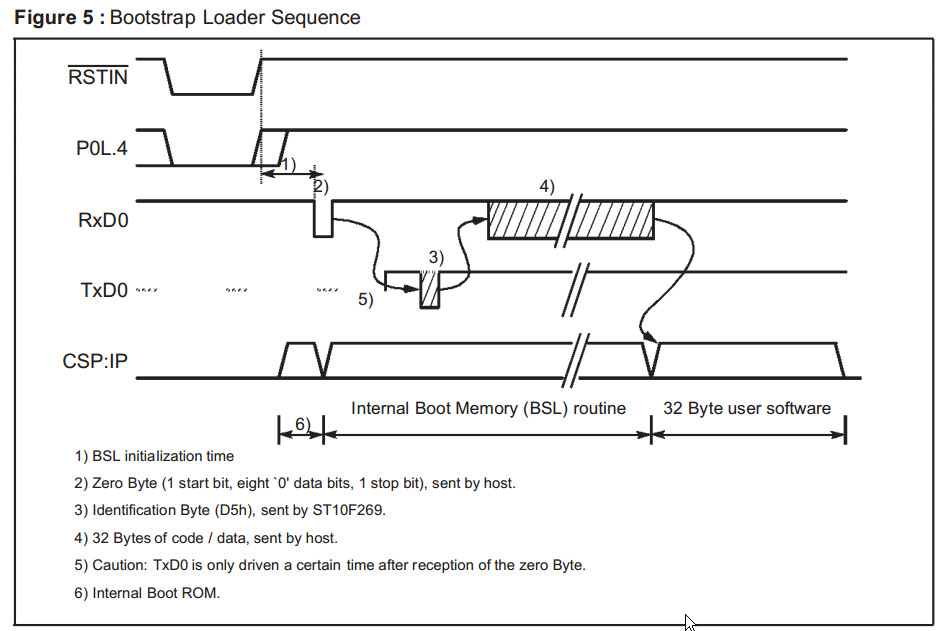Bootstrap Loader
The built-in bootstrap loader (BSL) of the ST10F269 provides a mechanism to load the startup program through the serial interface after reset.
In this case, no external memory or internal Flash memory is required for the initialization code starting at location 00'0000h (see Figure 5).
The bootstrap loader moves code/data into the internal RAM, but can also transfer data via the serial interface into an external RAM
using a second level loader routine. Flash Memory (internal or external) is not necessary, but it may be used to provide lookup tables
or core-code like a set of general purpose subroutines for I/O operations, number crunching, system initialization, etc.
The bootstrap loader can be used to load the complete application software into ROMless systems,
to load temporary software into complete systems for testing or calibration,
or to load a programming routine for Flash devices.
The BSL mechanism can be used for standard system startup as well as for special occasions
like system maintenance (firmer update) or end-of-line programming or testing.
Entering the Bootstrap Loader
The ST10F269 enters BSL mode when pin P0L.4 is sampled low at the end of a hardware reset.
In this case the built-in bootstrap loader is activated independent of the selected bus mode.
The bootstrap loader code is stored in a special Boot-ROM.
No part of the standard mask Memory or Flash Memory area is required for this.
After entering BSL mode and the respective initialization theST10F269 scans the RXD0 line to receive a zero Byte,
one start bit, eight `0' data bits and one stop bit. From the duration of this zero Byte it calculates the corresponding Baud rate factor
with respect to the current CPU clock, initializes the serial interface ASC0 accordingly and switches pin TxD0 to output.
Using this Baud rate, an identification Byte is returned to the host that provides the loaded data.
This identification Byte identifies the device to be booted. The identification byte is D5h for ST10F269.
Loading the Startup Code
After sending the identification Byte the BSL enters a loop to receive 32 Bytes via ASC0.
These Byte are stored sequentially into locations 00'FA40h through 00'FA5Fh of the internal RAM.
So up to 16 instructions may be placed into the RAM area.
To execute the loaded code the BSL then jumps to location 00'FA40h, which is the first loaded instruction.
The bootstrap loading sequence is now terminated, theST10F269 remains in BSL mode, however.
Most probably the initially loaded routine will load additional code or data, as an average application is likely
to require substantially more than 16 instructions. This second receive loop may directly use the pre-initialized interface ASC0
to receive data and store it to arbitrary user-defined locations. This second level of loaded code may be the final application code.
It may also be another, more sophisticated, loader routine that adds a transmission protocol to enhance the integrity of the loaded code or data.
It may also contain a code sequence to change the system configuration and enable the bus interface to store the received data into external memory.
This process may go through several iterations or may directly execute the final application.
In all cases the ST10F269 will still run in BSL mode, that means with the watchdog timer disabled and limited access to the internal Flash area.
All code fetches from the internal Flash area (00'0000h...00'7FFFh or 01'0000h...01'7FFFh, if mapped to segment 1) are redirected to the special Boot-ROM.
Data fetches access will access the internal Boot-ROM of the ST10F269, if any is available, but will return undefined data on ROMless devices.
Exiting Bootstrap Loader Mode
In order to execute a program in normal mode, the BSL mode must be terminated first.
The ST10F269 exits BSL mode upon a software reset (ignores the level on P0L.4) or a hardware reset (P0L.4 must be high).
After a reset the ST10F269 will start executing from location 00'0000h of the internal Flash or the external memory, as programmed via pin EA.
The behavior of the ST10Flasher is the following:
1. Send 0x0 byte
2. Wait for 0xD5 acknowledge from ST10
3. Send block of data to the ST10 that is a first code to get the content of the ST10 IDCHIP register
4. ST10 answers with 3 bytes: 0x5A (acknowledge of the monitor), IDCHIP_lowbyte, IDCHIP_highbyte
5. ST10Flasher send the complete Flash monitor for the target ST10 device
